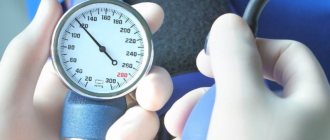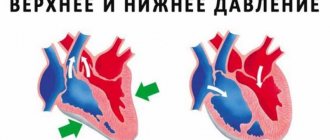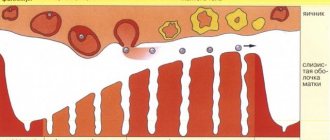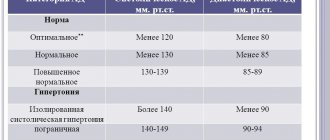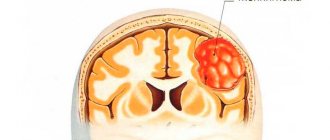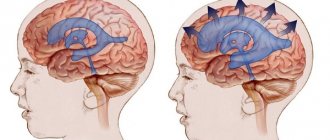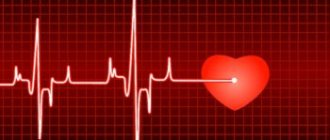Optimal blood pressure values and possible deviations
Using blood pressure indicators, it is possible to determine the force with which blood circulates in the human body, as well as how it affects the walls of the vascular network.
The intensity of blood circulation directly depends on the functioning of the heart. Pressure can be determined using two indicators, which during measurement reflect the quality of heart contraction. These indicators clearly characterize the upper and lower pressure:
- The systolic value indicates the minimum level of vascular resistance, which is measured while the heart is resting. This indicator is determined first using a tonometer.
- The diastolic value indicates the resistance of blood vessels to blood impulses when the heart contracts as much as possible. This indicator is determined by the second.
The difference between these types of blood pressure is called pulse pressure. Its value on average can reach from 30 to 50 mmHg, based on the age and state of health of the person.
Generally accepted standards
As you know, a pressure of 120/80 mmHg is considered normal. However, the following indicators are also considered optimal and not harmful to health: upper pressure – 91-130 mm Hg, lower pressure – 61-89 mm Hg. Art. This range is determined by the physiological characteristics of each person, his state of health, ongoing diseases and age. The level of blood pressure is purely individual for everyone, so its indicators may differ even in completely healthy people.
To do this, you can familiarize yourself with the table, which shows blood pressure parameters by age and gender of a person:
| Person's age | Systolic | Diastolic | ||
| men | women | men | women | |
| Up to 1 year | 96 | 95 | 66 | 65 |
| From 1 to 10 years | 103 | 103 | 69 | 70 |
| From 10 to 20 years | 123 | 116 | 76 | 72 |
| From 20 to 30 years | 126 | 120 | 79 | 75 |
| From 30 to 40 years | 129 | 127 | 81 | 80 |
| From 40 to 50 years | 135 | 127 | 81 | 80 |
| From 50 to 60 years | 142 | 144 | 85 | 85 |
| From 60 to 70 years | 145 | 159 | 82 | 85 |
| From 70 to 80 years | 147 | 157 | 82 | 83 |
| From 80 to 90 years | 145 | 150 | 78 | 79 |
Any unreasonable increase or decrease in indicators (especially in a child) should not go unnoticed, since this indicates the development of a serious disease.
It is especially important to monitor the difference in indicators in older people, since they experience pressure surges due to any factor that has a negative effect on the body.
What indicators are considered high?
Based on the parameters described in the table, high pressure levels are considered to be levels that exceed 120/80 mm. mercury column. However, sometimes the parameters may be higher due to the individual characteristics of the body or the age of the patient.
Pressure level 140/100 mm. and above indicates serious health problems, so the doctor will need to figure out what caused the increase in the indicator.
What values are considered low?
Based on the data presented in the table, it can be understood that indicators less than 120/80 mmHg are considered low. If the blood pressure level is 100/60 or less, this means critically low parameters that significantly worsen the patient’s condition.
What to do in this case? To restore normal blood pressure, it is necessary to measure the pressure in both arms, and then compare it with the data in the table - if they do not correspond to the norm for age, you should definitely visit a doctor.
Main signs of hypotension
Hypotension is determined by a decrease in blood pressure. 100/65 mm Hg. Art. It is not a serious pathology; some live with such pressure all their lives and feel well. Physiological hypotension does not require correction; it is an individual characteristic of a person. But in people with average indicators, a sharp and prolonged dilation of blood vessels causes a reduction in the speed of blood flow, a deterioration in intracranial blood supply, which leads to oxygen starvation of the brain. Therefore, patients with low blood pressure are lethargic, experience malaise, and increased drowsiness, which goes away by midday. And after lunch they want to sleep again. Manifestations of pathological hypotension include:
- weakness and dizziness in the morning, when you suddenly get out of bed, your vision becomes dark;
- due to dilation of the arteries, a dull headache in the forehead is disturbing;
- the person is easily irritated, whiny;
- performance is reduced;
- cold hands and feet;
- sometimes there is a decrease in temperature to 35.5–36 °C;
- Nausea and vomiting are possible;
- fainting occurs more often at a young age;
- memory and concentration are reduced.
Hypotonic people are weather-dependent, get tired quickly, their pulse quickens during physical activity, and they experience discomfort in the heart area. These are usually people of slight build, with pale skin. Low blood pressure is usually characteristic of young women. They show signs of the condition from adolescence.
It is important to know that the symptoms of hypotension can easily be confused with other dangerous ailments, so if the condition bothers you constantly, you need to undergo an examination.
Causes of non-pathological changes in indicators and surges in blood pressure
In addition to individual characteristics, there are also a number of factors due to which changes in blood pressure are possible - although the course of pathologies is not one of them. The human body, which is completely healthy, is able to control this indicator itself and, as necessary, reduce it and increase it. For example, after waking up, the blood pressure level may be slightly reduced, during the day it takes natural values, and in the evening it increases slightly.
Most often, physical exercise or exercise can cause changes in blood pressure levels. They require an increase in blood flow, which is necessary for proper nutrition of the muscles. That is why, after physical exertion, the pressure level can become 20 mmHg higher - and this will be considered normal for a person. Therefore, the measurement must be carried out in a calm state, which cannot change the indicators.
If the device shows a low or high level of pressure, this can be caused by a number of certain factors affecting the human body. These include:
- Frequent stressful situations.
- Eating stimulating foods (especially coffee, sweets and strong tea).
- Taking certain types of medications.
- Time of day (morning, afternoon or evening).
- The effect of emotional and physical stress on the body.
- The age of a person at which certain physiological characteristics appear.
Throughout life, various changes occur in the body, on which the volume of circulating blood depends, so blood pressure indicators at a certain period of life are individual.
For example, in pregnant women, the amount of blood doubles, which allows the fetus to be supplied with all the necessary nutrients and oxygen. Therefore, during pregnancy, blood pressure levels may change frequently. In this case, it will urgently need to be lowered or increased, otherwise the woman will notice the appearance of unpleasant symptoms of hypertension or hypotension.
What is the difference between high blood pressure and low blood pressure?
If we talk about the mechanisms of development of hypertension and hypotension, then in this case there are also differences:
High pressure
When blood pressure rises, a large amount of blood is released due to an overly active contraction of the heart. There are many reasons for this: narrowing of the lumen due to atherosclerosis, pathological disorders in the functioning of the heart itself, diseases of the endocrine and nervous systems, and kidneys.
When blood vessels are damaged, blood circulation is disrupted, the heart and brain do not receive proper nutrition. But the body independently tries to restore blood supply, pushing blood through narrow veins. This leads to increased blood pressure on the walls of blood vessels, which subsequently increases blood pressure.
If the tone in the vasomotor center is increased, then the activity in the sympathetic nervous system also increases. Because of this, the heart rate increases, increasing the force of contractions. This leads to an increase in blood fluid and its release into the aorta.
Low pressure
With reduced blood pressure, blood circulation is also impaired, but the mechanism for the development of hypotension is completely different. There is no release of blood, but on the contrary, blood flow in the vessels slows down and the speed of blood circulation in small capillaries decreases. Against this background, hypoxia develops, that is, oxygen starvation, due to which not only the brain and heart suffer, but also other internal organs.
Characteristic signs of high blood pressure
Signs of high and low blood pressure help to detect problems in the body in a timely manner.
High blood pressure that does not decrease over a long period of time is called hypertension. If it is mild or moderate, its symptoms may not manifest themselves at all. However, if the blood pressure level increases sharply, a person will notice signs of hypertension quite clearly.
If your blood pressure rises rapidly, the following symptoms appear:
- Pressing pain in the head.
- A feeling of tightness in the back of the head.
- Pulsation and buzzing in the ears. It can also cause stuffy ears, which manifests itself mainly with headaches.
- Sleep problems.
- Nose bleed.
- Inaccuracy and uncertainty of human movements.
- Heaviness and pain in the chest, tingling sensation.
- Swelling of the face and limbs.
- Nausea, vomiting.
- Throbbing of the eyeballs or blurred vision.
If the occurrence of high blood pressure is infrequent, the vessels will be overloaded over time, which will negatively affect the functioning of the organs to which they deliver blood. As a rule, such symptoms over time cause damage to the retina and pupil of the eye, brain and kidneys, which negatively affects human health.
With a frequent but short-lived increase in pressure, the heart begins to work more intensely due to the load placed on it, which ultimately causes the growth of this muscle. As a result of this, only the upper part of the muscle receives oxygen, while the inner layers of the myocardium suffer from its lack.
Among the pathological processes can be noted:
- Left ventricular hypertrophy.
- Hemorrhages in the retina of the eye.
- Reduced elasticity and fragility of blood vessels.
- Sclerosis of blood vessels and heart muscle.
- Impaired kidney function.
- Poor blood flow.
- Pulmonary edema.
- Tachycardia.
Unfortunately, critical blood pressure readings can be fatal, so it is important to be able to distinguish normal blood pressure levels from high or low blood pressure, and also to know the reason why the readings change.
How to recognize an increase or decrease in pressure without measuring instruments?
The first thing you can do is measure the ripple. To do this, you need to feel the pulse in the wrist and press on the vein so that the beating stops. If it disappears immediately, you have low blood pressure, but if the pulse is palpable even after pressing hard, your blood pressure is high.
Additionally, you can count the number of pulsating beats per minute. A healthy person should have from 60 to 80 beats.
You can also pay attention to the person’s appearance, since there is a difference between hypertensive and hypotensive patients, which is manifested in the following:
- With high blood pressure, a person behaves actively, can fuss, talk a lot. With low blood pressure, a person looks depressed.
- Pay attention to your skin tone. In hypertensive patients, the face becomes red and capillaries appear. Hypotonic people, on the contrary, turn pale.
- Hypertension is often observed in people who are overweight.
- Place your palm above your head, about 3 cm from its surface. With high blood pressure, heat will emanate from the head.
Symptoms of low blood pressure
The difference between high pressure and low pressure is significant - the main thing is to recognize it correctly, which is done using a special device or by characteristic symptoms.
Low pressure in the arm, which causes hypotension, is characterized by the following manifestations:
- Impaired attention and concentration.
- Pale skin.
- Fatigue, which causes a person to sleep longer.
- Frequent fainting.
- Lack of strength.
- General exhaustion of the body.
- Apathy.
- A depressive state in which a person may forget important things.
- An increase in temperature, which cannot be reduced with the help of medications or they will give a short-term effect. In some cases, the temperature drops below 36°C.
- Sensitivity of the skin to cold (this is especially pronounced on the upper and lower extremities).
- Insomnia.
- Lack of energy.
If a person notices such signs, it means that we are talking about the development of hypotension, which requires mandatory treatment. In this case, determining a low pressure indicator is quite simple - you should measure the pressure on both hands simultaneously (that is, first on one and then immediately on the other hand), and then compare the results.
Low blood pressure can create unfavorable conditions for the body to function. For example, they involve poor circulation, which leads to a lack of blood in the human brain.
Low blood pressure occurs especially often in hot weather. It is quite easy to recognize - with low blood pressure, a person becomes lethargic and weak, which immediately affects the mental and physical state.
Additional symptoms that will help identify low blood pressure include:
- Heart rhythm disturbances;
- Frequent loss of consciousness;
- Pain in the head;
- May cause blocked ears;
- Nausea, sometimes turning into vomiting;
- Deterioration of vision.
A person with low blood pressure may fall frequently, have difficulty standing on their feet, and may not understand what is happening around them. Also, such people are not able to lift heavy objects, and if a person does this, he will soon fall. In this case, the doctor needs to understand the patient’s condition and then prescribe comprehensive treatment.
How to normalize blood pressure?
Effective drugs
If the pressure surge occurs once, then drug treatment is not prescribed. The doctor will advise you to eliminate pathological factors from your life, establish a sleep and rest schedule, and go on a diet. Chronic hypertension requires complex treatment, which includes the use of the following groups of drugs:
Sedatives can be included in a complex therapeutic regimen for pathology.
- alpha and beta blockers;
- angiotensin receptor and calcium channel blockers;
- diuretics;
- renin and ACE inhibitors;
- sedatives;
- antispasmodics;
- means that normalize the functioning of the central nervous system.
Stably low blood pressure also requires proper treatment. To normalize indicators, medications of the following groups are prescribed:
- brain stimulants;
- vasoconstrictors;
- improving the functioning of the central nervous system;
- alpha adrenergic agonists;
- adaptogens of natural origin.
Other methods
Unstable blood pressure can be normalized with a therapeutic diet. Hypertensive patients need to exclude fatty, fried, spicy foods from the diet, limit the consumption of salt and caffeine-containing drinks. The menu is enriched with fresh fruits and vegetables, lean meat, sea fish, seafood, cereals, dairy and fermented milk products. The diet for hypotensive patients has a significant difference. With low blood pressure, a person is recommended to eat nourishing, fatty, high-calorie foods. You can drink alcoholic beverages, beer, sweet soda, black strongly brewed tea, coffee with sugar, sweets, chocolate, chocolate candies.
Magnetic therapy will help improve the patient's cardiovascular system.
Therapeutic exercises and physical therapy help strengthen the cardiovascular system and prevent a sharp rise or fall in blood pressure. Useful physiotherapeutic procedures are:
- electrophoresis;
- laser and magnetic therapy;
- ultraviolet irradiation;
- acupuncture;
- acupressure and manual massage;
- salt and mud baths;
- electrosleep.
How to determine your blood pressure level
If the measurement procedure is carried out correctly, it will be possible to obtain accurate readings. It is important to note that blood pressure values measured on different tonometers should not differ.
To carry out correct measurements, you need to gain certain skills and abilities:
- The person whose blood pressure is being measured should be as relaxed and calm as possible.
- During measurement, the cuff should be placed 3-5 cm above the bend of the elbow - and it should be tightened as much as the patient’s arm allows.
- The cuff must fit snugly to the arm, but not squeeze it.
- It is prohibited to speak or make any movements during measurement.
- A person should sit in a comfortable position so that the body is not tense.
- 30 minutes before the measurement, you must avoid all physical activity.
Another condition is that to obtain the correct result, it is advisable to calculate blood pressure parameters from both arms. If they differ by 10 mm or more. mercury column, after 15 minutes you need to take another measurement and then calculate the average.
The measurement technique is simple: after attaching the cuff to the arm, you need to use a bulb to force air into it to the 200 mm mark. After this, we slowly open the valve and begin to monitor the heartbeat: while it appears, we remember the first number, and when the shocks end, the second number.
How to understand what pressure is considered normal? After the measurement, you need to compare your indicators with those presented in the initial table. A deviation from the norm of 5-10 mmHg is not considered pathological if a person does not notice symptoms of high or low pressure. Otherwise, it is better to consult a doctor.
Pulse detection
Sometimes it happens that a person feels unwell, but there is no tonometer at hand. In such a situation, it will be possible to measure blood pressure without a special device - for this you will need to “find” the pulse.
This is done as follows:
- We find an artery on which the pulsation is clearly felt, and then lightly press on it;
- If the pulse is intermittent and irregular, it means that blood pressure is low;
- If the pulsation is too frequent, the indicator is high.
As a rule, it is best to measure the parameters using the pulse in the arm or in the neck, since the artery is felt best there.
Determination by external signs
How to distinguish high blood pressure from low blood pressure? Here are some rules characterizing changes in normal blood pressure parameters:
| Criterion | Symptoms | |
| Hypertension | Hypotension | |
| Skin color | If its level is high, the skin on the face will become red and the blood vessels will be clearly visible through it. | Low levels cause a sallow or pale skin tone. |
| Nature of headaches | High blood pressure leads to throbbing temporal and occipital pain. | Low pressure causes a dull pain in the frontal and temporal parts of the head. |
| General health | In the case of a sharp jump, there is a growing feeling of anxiety and stiffness of movements. However, if blood pressure gradually increases, a person may not experience any symptoms. | Weakness, drowsiness, loss of strength and general fatigue, possibly fainting. Meteor dependence is noted. |
Using such advice, it is not difficult to distinguish between high and low blood pressure, so it is important for every person to know them.
The level of pressure is important for every person, since with its help it is possible to accurately assess the state of a person’s health, as well as identify diseases occurring in the body. To avoid complications, it is recommended to measure blood pressure regularly, which will help closely monitor your health.
Pressure measurement methods
It is important to prepare properly before taking measurements. To do this, it is recommended to adhere to the following rules: . refuse physical activity; eliminate smoking; 1 hour before, stop eating food, caffeine-containing drinks and alcoholic drinks; sit comfortably and lean on the back of a chair; place your hand in a comfortable position at heart level; do not speak or move.
- refuse physical activity;
- eliminate smoking;
- 1 hour before, stop eating food, caffeine-containing drinks and alcoholic drinks;
- sit comfortably and lean on the back of a chair;
- place your hand in a comfortable position at heart level;
- do not speak or move.
To find out your blood pressure yourself without a tonometer, you should use various methods. Thanks to their use, it will be possible to take timely measures that will help avoid critical marks and maintain normal health.
Many people are interested in which hand should they measure blood pressure on. Experts say that even a slight difference in the indicators on the left and right hands may indicate dangerous disturbances in the functioning of blood vessels. Therefore, it is worth checking both hands and considering higher values as correct.
Determination of blood pressure by pulse
This is a fairly simple and effective measurement method that has become widespread. So, how can you determine your blood pressure using your pulse?
No special equipment is required to carry out the procedure. The main thing is to time it correctly and perform simple mathematical calculations. To use this method, you should do the following:
- Take a comfortable position at the table. Place an electronic or mechanical watch nearby.
- Imagine something pleasant for 2-3 minutes to calm the nervous system.
- Gently place your fingers on your right or left wrist. It is important to ensure that the cuffs of clothing do not compress the blood vessels.
- Count the number of heart beats for 30 seconds.
- Multiply the results by two to determine the number of beats per minute.
If the result is a value less than 60, this indicates low blood pressure.
Normal parameters are 60-80 beats per minute. If the pulse value exceeds the specified standard level, an increase in blood pressure can be suspected. If doubts arise about the correctness of the calculations, the procedure is carried out again.
Using a pendulum
To measure blood pressure this way, you should use a device such as a pendulum. It can be made from scrap items. For this purpose you will need:
- thin lace or thread 20 cm long;
- a load that can be suspended - it is quite acceptable to use a ring, a wire bent into a wheel, a nut, a paper clip or other small object;
- ruler 20-30 cm.
To measure blood pressure correctly, you should do the following:
- Make a pendulum from available items. To do this, attach a weight to the end of the thread. The second tip should remain free.
- Sit the person down and place his forearm on a stationary surface. It is better to measure on your left hand, but you can do this on your right as well.
- Place the beginning of the ruler scale in the elbow bend. You can also make marks on the skin of the forearm. This is done after a few centimeters.
- Take the free end of the thread with a weight and hang it above the ulnar fossa. This must be done at the beginning of the measuring scale. It is important that the pendulum does not touch the skin, but is close enough to its surface and can perform oscillatory movements.
- Try to keep the pendulum in a stationary position. This should be done for a few seconds. After this, you need to begin to slowly move it parallel to the surface of the forearm. In this case, you need to move in the direction of the hand.
- As it moves, the pendulum can perform chaotic movements. However, at some distance a clear wobble will appear. They are performed in the transverse direction to the axis of the ruler and forearm.
- It is necessary to note the point at which the vibrations began. By multiplying this figure by 10, you can get the systolic (upper) pressure.
- Move the beginning of the ruler scale to the transverse fold of the skin, which is located above the hand.
- With your right hand, place the pendulum over the beginning of the meter and slowly move it towards the ulnar fossa. This must be done along the direction of the ruler.
- Mark on the ruler the point at which the pendulum begins to perform the same type of oscillations in the transverse direction. By multiplying this indicator by 10, you can understand what diastolic (lower) pressure a person has.
Treatment of hypertension
High blood pressure, regardless of its severity, should be treated. Such a diagnosis leads to significant changes in almost all organs and systems of the body. The necessary therapy must be prescribed by a doctor. It is he who evaluates all possible risk factors, selects appropriate medications and establishes appropriate medical examinations and procedures. First of all, you need to know how to determine high or low blood pressure at home. In case of deviations from the norm, be sure to consult a doctor.
Tangible benefits for improving a person’s well-being will be provided by reducing the amount of salt in food, abstaining from smoking and excessive drinking of alcohol, increasing physical activity (after consultation with a doctor), and the ability to rest and relax after a hard day. For each person, personal therapy should be developed, prescribed by a competent doctor. Drug therapy for hypertension is necessary when there is a persistent increase in pressure above 160 to 90 millimeters. rt. Art. For patients with concomitant pathologies (cardiac disorders and renal failure), characteristics from 130 to 85 millimeters are considered unsafe. rt. Art. and higher.
Pulse detection
Sometimes it happens that a person feels unwell, but there is no tonometer at hand. In such a situation, it will be possible to measure blood pressure without a special device - for this you will need to “find” the pulse.
This is done as follows:
- We find an artery on which the pulsation is clearly felt, and then lightly press on it;
- If the pulse is intermittent and irregular, it means that blood pressure is low;
- If the pulsation is too frequent, the indicator is high.
As a rule, it is best to measure the parameters using the pulse in the arm or in the neck, since the artery is felt best there.
We bring blood pressure back to normal
Tips on how to lower blood pressure:
- You should always have blood pressure lowering medications with you. The doctor may prescribe the following groups of drugs:
- Angiotensin-converting enzyme inhibitors. They lower blood pressure and protect the organ system that provides blood circulation in the body. The most common: Enalapril, Captopril.
- Diuretics. Remove excess fluid from the body. The most common: Chlorthalidone, Furosemide.
For hypertension, it is important to have blood pressure-lowering medications on hand.
- Potassium antagonists. Prevents pathological changes in the blood circulation of the brain. The most common: Lecranicidin, Felodilin.
- Beta blockers. Due to the high risk of side effects, it is rarely prescribed recently. The most common: Atenolol, Carvedilol.
- Follow a diet. Alcoholic drinks, salt, confectionery, baked goods, caffeine, smoked products, fatty foods, and spices are excluded from the diet. The menu should be dominated by freshly squeezed juices and low-fat fermented milk products. It is better to eat small portions 5-6 times a day. The last time to eat food is no later than 2 hours before bedtime.
- Physiotherapy: magnetic therapy, electrosleep.
- Ethnoscience. Juice from carrots, currants, and beets reduces blood pressure. You can make a decoction of rose hips.
- Prevention. Walks in the fresh air, light physical activity.
Tips on how to increase blood pressure:
- Medicines. These include “Dopamine”, “Citramon”, “Mesotan”, “Papazol”. All medications should be taken as directed or recommended by your doctor. Tinctures of medicinal herbs are taken before meals, 20–30 drops. For headaches, you need to take any analgesic.
- Physiotherapy. You can prepare a decoction from the following medicinal plants: lemongrass, ginger, ginseng, St. John's wort. Regular intake of medicinal decoctions stabilizes the indicators.
- Dieting. The food should be dominated by turkey, pig meat, sea fish, and beef. Products should contain a lot of potassium and iron. The menu should include apples, potatoes, pomegranates, liver, and raisins. Food products made from milk should be high in fat content - cottage cheese, milk, cow butter. Spices and pickles increase blood pressure levels. In the morning, it is recommended to drink a cup of coffee and eat a sandwich with butter.
- Prevention measures. Sleep should last 8–10 hours. Walking in the fresh air is a must. Light gymnastics is useful.
By following the above recommendations, you can minimize possible complications. If you don't know how to normalize and can't figure out what the pressure is, consult a doctor.
Oscillometric diagnostics
How to determine high or low blood pressure during a headache? Oscillometric diagnostics will help you. It involves the use of a tonometer, but does not require listening through a phonendoscope. The device displays pulse and pressure values on the screen. Such tonometers are mechanical and automatic. Mechanical ones involve the use of a bulb, while automatic ones pump the air themselves by pressing the “Start” button on the device screen. Automatic blood pressure monitors are worn on the wrist.
Recognition of acute forms of pressure changes
It is especially important to distinguish hypertension from hypotension in the critical form of manifestation of the pathology. Hypotension in an acute state manifests itself due to acute blood loss or due to medication, the development of allergic reactions such as anaphylactic shock. The patient's skin becomes white or sallow, hands may shake, and cold, clammy sweat covers the surface of the body. The condition requires qualified assistance, and first the patient must be helped to assume a horizontal position.
With hypertension, there is a risk of cerebral hemorrhage or myocardial infarction. The condition is abrupt, a jump in pressure occurs within a few seconds, due to physical or emotional stress. A person may sweat, blush, or sit on the floor, depending on the consequences of the jump. He may feel nauseous, vomit when he gets up, and may also have a nose bleed.
Only a doctor with many years of experience can distinguish high blood pressure from low blood pressure without using a tonometer. In other cases, each symptom is recorded and then confirmed with numerical indicators. Pathologies in 80% of cases require drug treatment. The use of any medications for concomitant pathologies should be agreed with a specialist for their effect on blood pressure.
People suffering from changes in blood pressure are often interested in the question: how to understand high or low blood pressure. Feeling unwell, accompanied by headaches, is a clear sign that blood pressure readings are not normal.
In this article we will look in detail at how to determine whether blood pressure is high or low.
What to do to increase blood pressure?
Medicines, diet, herbal medicines and an active lifestyle contribute to an increase in blood pressure levels. Medicines should be prescribed exclusively by a specialist. Herbal medicines may include the following herbs and plant components:
- ginseng root;
- ginger root;
- St. John's wort;
- lemongrass;
- immortelle.
Long-term use of herbal remedies will help bring blood pressure back to normal.
St. John's wort herb raises blood pressure well
If you have hypotension, it is very important to adhere to proper nutrition. Be sure to eat meat (pork, chicken, beef, turkey, duck), fish. You need to include foods containing iron and potassium in your diet. Prominent representatives are apples, beef liver, pomegranate, potatoes, raisins, chocolate, cocoa.
You can and should eat fatty fermented milk products: homemade cottage cheese, sour cream, milk, cream, natural yogurt. Spicy, fried, and salty foods should be consumed in moderation.
It is important for hypotensive patients to observe the following preventive measures:
- sleep at least 8-9 hours;
- take a contrast shower in the morning;
- doing physical exercise;
- walk and breathe fresh air;
- normalize diet;
- give up bad habits.
In the morning you need to take a contrast shower
When can you suspect problems with blood pressure?
If the following symptoms appear, it is recommended to determine whether a person has high or low blood pressure and do so as quickly as possible:
- headache;
- feeling drowsy and tired after sleep;
- dizziness;
- feeling of heaviness in the head;
- heartache;
- the appearance of “flies” before the eyes;
- sudden loss of consciousness.
Not only the doctor, but also the patient’s relatives can determine what pressure a patient has. This can be done using a tonometer. There are models with electronic pressure calculation, which makes life easier for patients and reduces the duration of the procedure. The pressure must be measured on both hands and based on average values. The procedure itself is painless and does not take more than 5 minutes.
Blood pressure shows the force with which the blood flow acts on the vascular walls
Depending on whether the blood pressure is high or low, the doctor prescribes treatment for the patient. If the readings on the tonometer rise above 140/90 mmHg. Art., a person develops arterial hypertension or hypertension. It is important to monitor the numbers throughout the week by measuring your blood pressure daily. Low blood pressure has no specific criteria, but if it is lower than 100/60 mmHg. Art, then this can be regarded as hypotension.
What values are considered low?
Based on the data presented in the table, it can be understood that indicators less than 120/80 mmHg are considered low. If the blood pressure level is 100/60 or less, this means critically low parameters that significantly worsen the patient’s condition.
What to do in this case? To restore normal blood pressure, it is necessary to measure the pressure in both arms, and then compare it with the data in the table - if they do not correspond to the norm for age, you should definitely visit a doctor.
Arterial hypotension
Provoking factors:
- vegetative-vascular dystonia (VSD);
- hormonal imbalance;
- heredity;
- chronic fatigue;
- physical inactivity;
- diabetes;
- bearing a child;
- disruption of the thyroid gland.
People suffering from hypotension are more susceptible to insomnia. All day they are in a lethargic and apathetic state. And in the evening their activity increases.
Throughout the day, patients with this diagnosis experience depression, apathy, fatigue, and in the evening they begin an activity cycle
How can you tell if your blood pressure is low? The following symptoms will help diagnose the disease:
- memory impairment;
- drowsiness;
- increased heart rate regardless of exercise;
- severe fatigue;
- disruption of the digestive system;
- weather dependence.
Hypotension is dangerous due to oxygen starvation of vital organs.
What to do at home?
If the pressure changes very sharply and is accompanied by very poor health, call an ambulance. If the condition is tolerable, measure the pressure using a special device - a tonometer. However, not everyone has it in stock, so you can do without it. To do this, you need to place your index and middle finger on the wrist of your left hand and use a stopwatch to count the number of heartbeats. If your pulse is rapid, it means your blood pressure is high. Protruding veins on the forehead, neck, and pulsating temples can also be considered evidence of increased pressure.
Pressure measurement is also influenced by various factors - hot weather, active physical activity, lack of air (for example, in a small room, in transport), in stressful situations. Blood pressure levels should only be measured in a calm state. 10-15 minutes before the manipulation you need to sit, relax and calm down. Only then can the data obtained be reliable.
